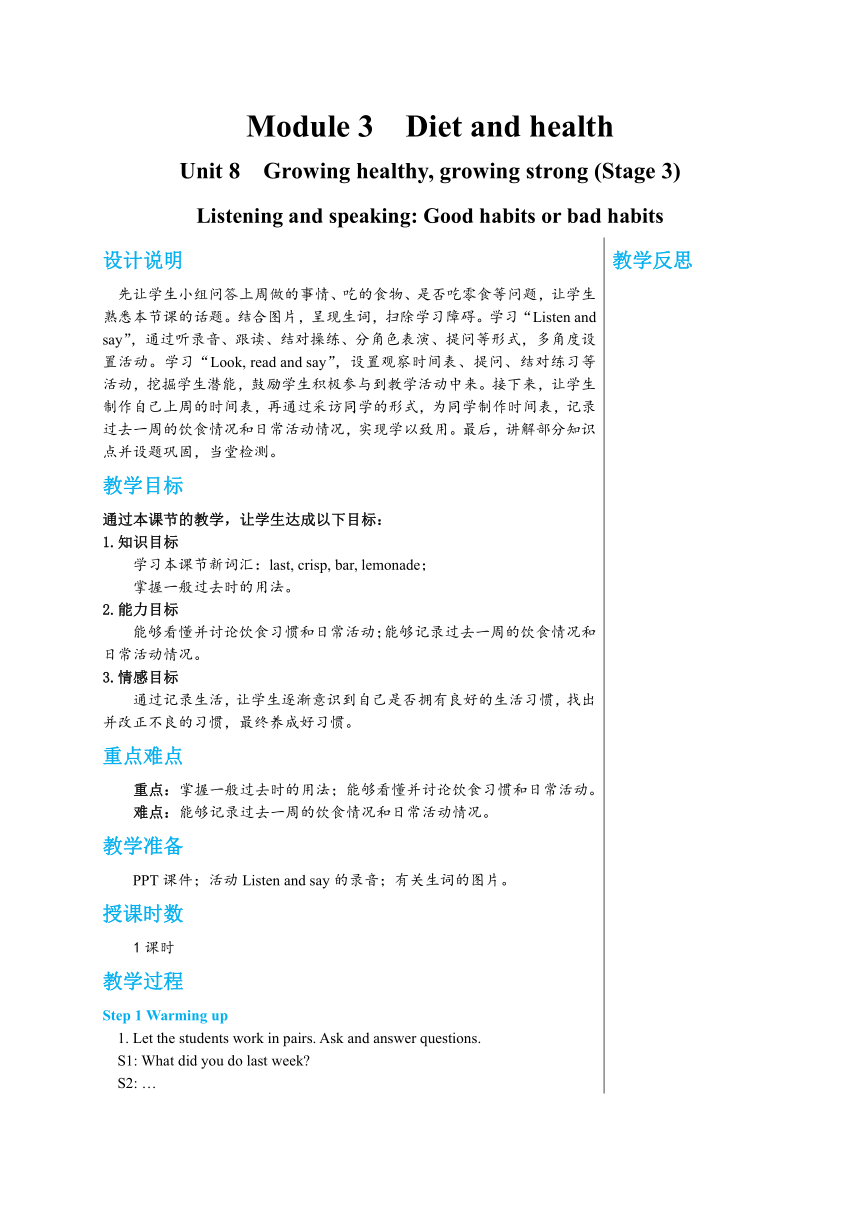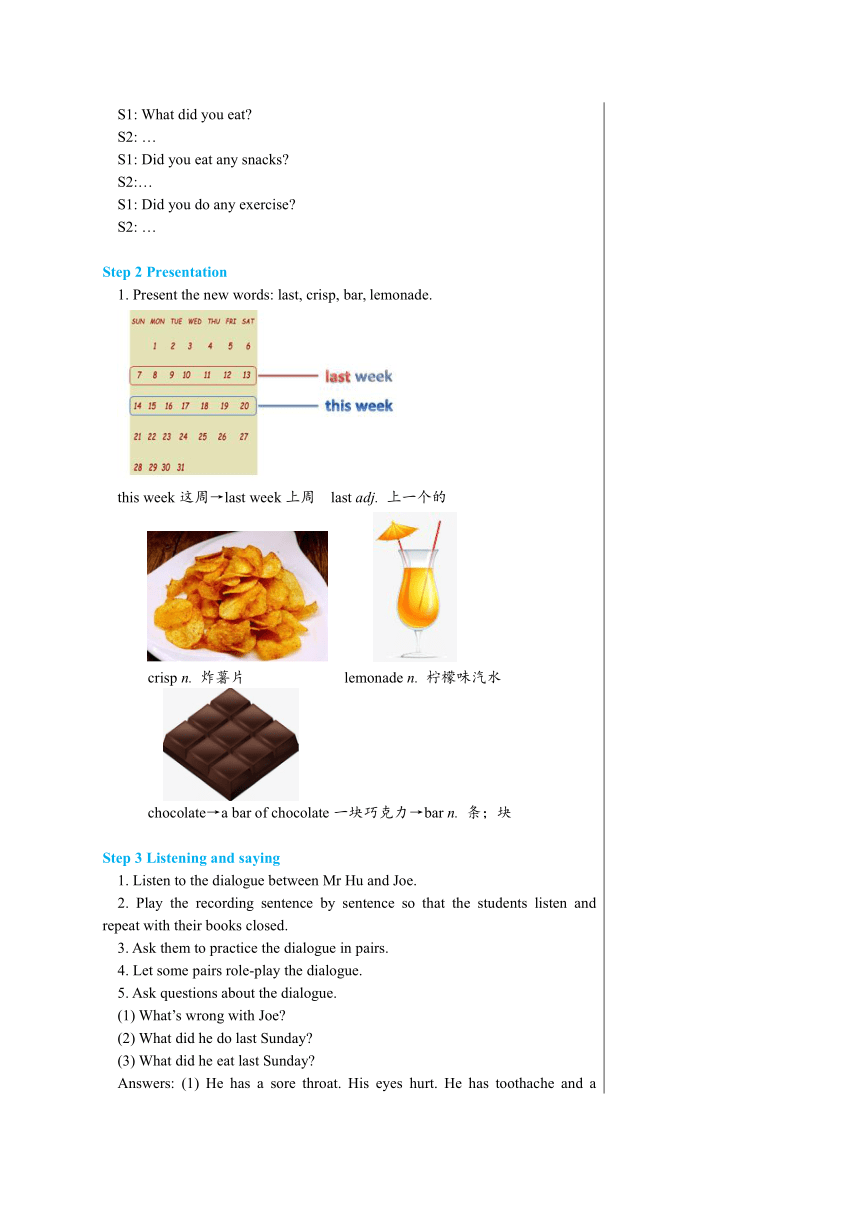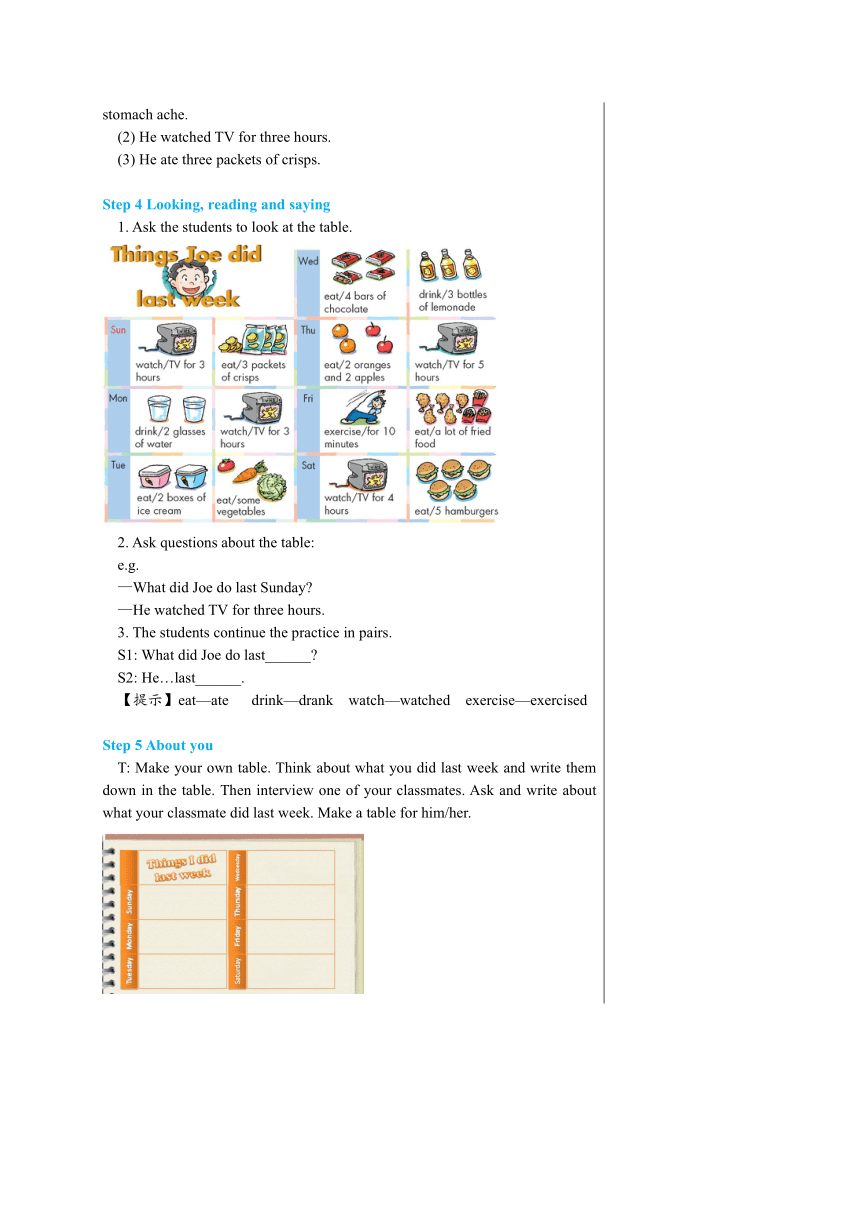Module 3 Unit 8 Growing healthy, growing strong Listening and speaking 教案
文档属性
| 名称 | Module 3 Unit 8 Growing healthy, growing strong Listening and speaking 教案 |

|
|
| 格式 | docx | ||
| 文件大小 | 1.4MB | ||
| 资源类型 | 教案 | ||
| 版本资源 | 牛津上海版(试用本) | ||
| 科目 | 英语 | ||
| 更新时间 | 2021-09-26 21:14:55 | ||
图片预览





文档简介
Module
3
Diet
and
health
Unit
8
Growing
healthy,
growing
strong
(Stage
3)
Listening
and
speaking:
Good
habits
or
bad
habits
设计说明
先让学生小组问答上周做的事情、吃的食物、是否吃零食等问题,让学生熟悉本节课的话题。结合图片,呈现生词,扫除学习障碍。学习“Listen
and
say”,通过听录音、跟读、结对操练、分角色表演、提问等形式,多角度设置活动。学习“Look,
read
and
say”,设置观察时间表、提问、结对练习等活动,挖掘学生潜能,鼓励学生积极参与到教学活动中来。接下来,让学生制作自己上周的时间表,再通过采访同学的形式,为同学制作时间表,记录过去一周的饮食情况和日常活动情况,实现学以致用。最后,讲解部分知识点并设题巩固,当堂检测。
教学目标
通过本课节的教学,让学生达成以下目标:
1.知识目标
学习本课节新词汇:last,
crisp,
bar,
lemonade;
掌握一般过去时的用法。
2.能力目标
能够看懂并讨论饮食习惯和日常活动;能够记录过去一周的饮食情况和日常活动情况。
3.情感目标
通过记录生活,让学生逐渐意识到自己是否拥有良好的生活习惯,找出并改正不良的习惯,最终养成好习惯。
重点难点
重点:掌握一般过去时的用法;能够看懂并讨论饮食习惯和日常活动。
难点:能够记录过去一周的饮食情况和日常活动情况。
教学准备
PPT课件;活动Listen
and
say的录音;有关生词的图片。
授课时数
1课时
教学过程
Step
1
Warming
up
1.
Let
the
students
work
in
pairs.
Ask
and
answer
questions.
S1:
What
did
you
do
last
week?
S2:
…
S1:
What
did
you
eat?
S2:
…
S1:
Did
you
eat
any
snacks?
S2:…
S1:
Did
you
do
any
exercise?
S2:
…
Step
2
Presentation
1.
Present
the
new
words:
last,
crisp,
bar,
lemonade.
this
week这周→last
week上周
last
adj.
上一个的
crisp
n.
炸薯片
lemonade
n.
柠檬味汽水
chocolate→a
bar
of
chocolate一块巧克力→bar
n.
条;块
Step
3
Listening
and
saying
1.
Listen
to
the
dialogue
between
Mr
Hu
and
Joe.
2.
Play
the
recording
sentence
by
sentence
so
that
the
students
listen
and
repeat
with
their
books
closed.
3.
Ask
them
to
practice
the
dialogue
in
pairs.
4.
Let
some
pairs
role-play
the
dialogue.
5.
Ask
questions
about
the
dialogue.
(1)
What’s
wrong
with
Joe?
(2)
What
did
he
do
last
Sunday?
(3)
What
did
he
eat
last
Sunday?
Answers:
(1)
He
has
a
sore
throat.
His
eyes
hurt.
He
has
toothache
and
a
stomach
ache.
(2)
He
watched
TV
for
three
hours.
(3)
He
ate
three
packets
of
crisps.
Step
4
Looking,
reading
and
saying
1.
Ask
the
students
to
look
at
the
table.
2.
Ask
questions
about
the
table:
e.g.
—What
did
Joe
do
last
Sunday?
—He
watched
TV
for
three
hours.
3.
The
students
continue
the
practice
in
pairs.
S1:
What
did
Joe
do
last______?
S2:
He…last______.
【提示】eat—ate
drink—drank
watch—watched
exercise—exercised
Step
5
About
you
T:
Make
your
own
table.
Think
about
what
you
did
last
week
and
write
them
down
in
the
table.
Then
interview
one
of
your
classmates.
Ask
and
write
about
what
your
classmate
did
last
week.
Make
a
table
for
him/her.
Step
6
Language
points
1.
Mr
Hu,
I
have
a
sore
throat.胡老师,我嗓子痛。
have
(a/an)+表示疾病的名词
患……病
My
brother
has
toothache.我哥哥牙痛。
Linda
has
a
stomach
ache.琳达胃痛。
2.
What
did
you
do
last
Sunday,
Joe?乔,你上周日做了什么?
last
①〔形容词〕上一个的
Last
year,
we
had
a
big
party.去年我们举行了盛大的聚会。
②〔形容词〕最后的;最末的
He
is
the
last
student
to
come
to
school.他是最后一个来学校的。
③〔动词〕持续
The
meeting
lasts
for
two
hours.会议持续了两个小时。
Step
7
Homework
1.
Make
a
timetable
to
show
what
your
parents
did
last
week.
2.
Preview
the
content
on
page
62.
当堂达标
选择最恰当的答案
1.
Dick
_______
a
large
bowl
of
noodles
yesterday.
A.
ate
B.
eat
C.
eats
D.
is
eating
2.
—_______
did
you
do
yesterday?
—I
played
basketball
with
my
brother.
A.
What
B.
When
C.
Where
D.
How
3.
—What’s
wrong
with
Jane?
—_______.
A.
She
goes
to
sleep
B.
She
went
to
school
early
C.
She
has
toothache
D.
She
feels
well
答案:1-3
AAC
板书设计
Unit
8
Growing
healthy,
growing
strong
Listening
and
speaking:
Good
habits
or
bad
habitslast
crisp
bar
lemonade
eat—ate
drink—drank
watch—watched
exercise—exercised一般过去时
have(a/an)+表示疾病的名词
教学反思
Module
3
Diet
and
health
Unit
8
Growing
healthy,
growing
strong
(Stage
4)
Listening
and
speaking:
Good
habits
or
bad
habits
设计说明
向学生呈现约翰上周做的事情的表格,让他们用一般过去时谈论约翰所做的事情并讨论约翰的习惯是好的还是坏的,由此引发学生对于生活习惯的思考,并导入新课。学习“Say
and
act”,通过默读、听录音、结对练习、表演、提问等形式,使学习更加丰富有趣。完成“Discuss
and
write”部分,让学生结合表格提炼出乔生活习惯的重要内容。接下来,让学生小组讨论乔的不良习惯,并为他提建议。由此让学生用辩证的思维观察和处理问题。另外,通过结对练习,锻炼学生的口头表达能力。上节课的课堂活动还设置了为同学列时间表这一任务,因此,本节课可以在此基础上,让学生们发挥主观能动性为同学提建议,改变生活中的不良习惯。这样既能实现课堂的有机衔接,又能锻炼学生的思维,引导他们充分利用所学知识解决实际问题。最后讲解几个知识点并做题检测,巩固所学内容。
教学目标
通过本课节的教学,让学生达成以下目标:
1.知识目标
复习巩固too
many、too
much和much
too的用法;
学习fewer、less和more的区别;
熟练掌握用情态动词should提建议。
2.能力目标
能够听懂有关生活习惯的对话;能够读懂日常饮食和活动的表格,组合信息并表达出来;能够为他人的不良习惯提建议。
3.情感目标
提升学生发现问题、解决问题的能力,促进学生良好习惯的养成。
重点难点
重点:能够听懂有关生活习惯的对话;能够读懂日常饮食和活动的表格,组合信息并表达出来;
难点:能够为他人的不良习惯提建议。
教学准备
PPT课件;活动Say
and
act的录音。
授课时数
1课时
教学过程
Step
1
Looking
and
say
1.
Present
John’s
table
which
shows
what
he
did
last
week.
Sunday
exercise
/
for
10
minutes
eat/
a
lot
of
fried
foodMonday
eat/
4
bars
of
chocolate
drink/
3
bottles
of
juiceTuesday
drink/
2
glasses
of
water
watch/TV
for
3
hoursWednesday
eat/
a
lot
of
fried
food
play/
computer
games
for
3
hoursThursday
eat/3
packets
of
crisps
eat/2
boxes
of
ice
creamFriday
drink/
3
glasses
of
water
go
to
bed/
at
10
p.m.Saturday
watch/TV
for
3
hours
eat/
a
lot
of
fried
food
2.
Let
the
students
look
at
the
table
in
pairs.
Ask
them
to
talk
about
the
things
John
did
last
week.
Give
them
an
example
like
this:
—What
did
John
do
last
Sunday?
—He
exercised
for
10
minutes.
—What
did
John
eat
last
Sunday?
—He
ate
a
lot
of
fried
food.
3.
Allow
them
to
continue
the
practice.
4.
Let
different
pairs
talk
about
the
table,
like
this:
T:
Would
you
like
to
tell
us
what
John
did
on
Monday/Tuesday/Wednesday/
Thursday/Friday/Saturday?
5.
Ask
them
to
work
in
groups.
Discuss
whether
John
has
good
or
bad
habits.
Tell
the
reason.
Step
2
Saying
and
acting
1.
Give
the
students
time
to
read
“Say
and
act”
silently.
2.
Play
the
recording.
The
students
listen.
3.
In
pairs,
students
practise
the
dialogue.
Select
pairs
to
act
it
out.
4.
Ask
questions
about
the
dialogue
to
make
sure
they
understand
well.
(1)
What
did
Joe
do?
(2)What
is
Joe
going
to
do?
5.
Check
the
answers.
Answers:
(1)
He
watched
too
much
TV
and
ate
too
many
crisps.
(2)
He
is
going
to
change
his
bad
habits.
He
is
going
to
watch
less
TV,
eat
fewer
crisps
and
more
fruit.
Step
3
Discussing
and
writing
1.
Present
Joe’s
table
again.
2.
Let
the
students
complete
the
report
in
“Discuss
and
write”.
Joe’s
bad
habits
Joe
ate
too
many
crisps
and
hamburgers.
He
ate
too
much
_______,
_______
and
_______.
He
drank
too
much
_______.
He
watched
too
much
_______.
He
did
not
eat
enough
_______
or
_______.
He
did
not
drink
enough
_______.
3.
Select
some
students
to
read
out
their
sentences.
4.
Check
the
answers
together.
Answers:
ice
cream,
chocolate,
fried
food;
lemonade;
TV;
fruit,
vegetables;
water
Step
4
Looking
and
saying
1.
Ask
students
to
look
at
Joe’s
table
and
give
suggestions
on
his
bad
habits.
2.
Let
students
work
in
groups.
And
write
the
suggestions
down.
3.
Select
some
groups
to
say
their
suggestions.
Step
5
Thinking,
saying
and
writing
1.
Get
the
students
to
complete
the
suggestions.
Suggestions
·Joe
should
eat
fewer
crisps
and
hamburgers.
·He
should
eat
more
__________.
·he
should
eat
less
__________.
·he
should
drink
more
__________.
·he
should
drink
less
__________.
·he
should
__________.
2.
Select
some
of
the
students
to
read
a
suggestion.
3.
Check
the
answers.
Answers:
fruit
and
vegetables,
ice
cream,
chocolate
and
fried
food,
water,
lemonade,
watch
less
TV
4.
In
pairs,
students
practise
the
dialogue.
5.
Select
some
pairs
to
say
a
dialogue.
Step
6
Thinking
and
saying
1.
Look
at
the
table
that
you
made
for
your
classmate.
2.
Think
about
the
wrong
things
that
he/she
did
last
week.
(name)’s
bad
habits
He/She
ate
too
many
_______.
He/She
ate
too
much
_______.
He/She
drank
too
many
_______.
He/She
drank
too
much
_______.
He/She
did
not
eat
enough
_______.
He/She
did
not
drink
enough
_______.
3.
Give
him/her
some
suggestions.
Suggestions
He/She
should
eat
_______.
He/She
should
eat
more
_______.
He/She
should
eat
less
_______.
He/She
should
drink
more
_______.
He/She
should
drink
less
_______.
He/She
should
_______.
Step
7
Language
points
1.
I’m
going
to
change
my
bad
habits.我打算改掉我的坏习惯。
change(1)〔动词〕改变
It’s
time
to
change
our
bad
habits.
是时候改变我们的坏习惯了。
(2)〔名词〕变化
Great
changes
have
taken
place
here.这儿发生了很大的变化。
2.
I’m
going
to
watch
less
TV,
eat
fewer
crisps
and
more
fruit.我会少看些电视,少吃些炸薯片,多吃水果。
辨析:fewer,
less与more
fewerfew的比较级更少修饰可数名词复数lesslittle的比较级更少修饰不可数名词moremany的比较级更多修饰可数名词复数much的比较级修饰不可数名词
Eat
fewer
hamburgers,
Jane.少吃些汉堡包,简。
There
is
going
to
be
less
pollution
here.这儿污染将会更少。
More
visitors
come
to
visit
the
Great
Wall.更多的游客前来游览长城。
I
need
more
milk.我需要更多的牛奶。
Step
8
Homework
1.
Complete
the
exercises
in
Workbook
7A
on
page
54.
2.
Preview
“Read”
on
page
63.
当堂达标
Ⅰ.
选词填空
too
many
too
much
much
too
1.
I
have
_______
homework
to
do
today.
2.
The
teacher
told
him
not
to
talk
______.
3.
The
work
is
_______
hard
for
me.
4.
There
are
_______
people
in
the
park.
fewer
less
more
5.
He
ate
some
eggs.
There
are
_______
on
the
plate.
6.
You
should
eat
_______
fruit.
It’s
good
for
your
health.
7.
There
is
_______
milk
in
the
glass.
Ⅱ.
根据所给要求完成句子
1.
crisps,
fewer,
Linda,
eat,
should
(连词成句)
______________________________________________________________.
2.
is
going
to,
brother,
bad,
my,
change,
habits,
his
(连词成句)
______________________________________________________________.
答案:
Ⅰ.
1.
too
much 2.
too
much 3.
much
too 4.
too
many 5.
fewer 6.
more
7.
less
Ⅱ.
1.
Linda
should
eat
fewer
crisps
2.
My
brother
is
going
to
change
his
bad
habits
板书设计
Unit
8
Growing
healthy,
growing
strong
Listening
and
speaking:
Good
habits
or
bad
habitschange
should
too
many,
too
much,
much
too
be
going
to
fewer,
less与more
He
should
eat
less...
drink
more...
watch
fewer...
教学反思
3
Diet
and
health
Unit
8
Growing
healthy,
growing
strong
(Stage
3)
Listening
and
speaking:
Good
habits
or
bad
habits
设计说明
先让学生小组问答上周做的事情、吃的食物、是否吃零食等问题,让学生熟悉本节课的话题。结合图片,呈现生词,扫除学习障碍。学习“Listen
and
say”,通过听录音、跟读、结对操练、分角色表演、提问等形式,多角度设置活动。学习“Look,
read
and
say”,设置观察时间表、提问、结对练习等活动,挖掘学生潜能,鼓励学生积极参与到教学活动中来。接下来,让学生制作自己上周的时间表,再通过采访同学的形式,为同学制作时间表,记录过去一周的饮食情况和日常活动情况,实现学以致用。最后,讲解部分知识点并设题巩固,当堂检测。
教学目标
通过本课节的教学,让学生达成以下目标:
1.知识目标
学习本课节新词汇:last,
crisp,
bar,
lemonade;
掌握一般过去时的用法。
2.能力目标
能够看懂并讨论饮食习惯和日常活动;能够记录过去一周的饮食情况和日常活动情况。
3.情感目标
通过记录生活,让学生逐渐意识到自己是否拥有良好的生活习惯,找出并改正不良的习惯,最终养成好习惯。
重点难点
重点:掌握一般过去时的用法;能够看懂并讨论饮食习惯和日常活动。
难点:能够记录过去一周的饮食情况和日常活动情况。
教学准备
PPT课件;活动Listen
and
say的录音;有关生词的图片。
授课时数
1课时
教学过程
Step
1
Warming
up
1.
Let
the
students
work
in
pairs.
Ask
and
answer
questions.
S1:
What
did
you
do
last
week?
S2:
…
S1:
What
did
you
eat?
S2:
…
S1:
Did
you
eat
any
snacks?
S2:…
S1:
Did
you
do
any
exercise?
S2:
…
Step
2
Presentation
1.
Present
the
new
words:
last,
crisp,
bar,
lemonade.
this
week这周→last
week上周
last
adj.
上一个的
crisp
n.
炸薯片
lemonade
n.
柠檬味汽水
chocolate→a
bar
of
chocolate一块巧克力→bar
n.
条;块
Step
3
Listening
and
saying
1.
Listen
to
the
dialogue
between
Mr
Hu
and
Joe.
2.
Play
the
recording
sentence
by
sentence
so
that
the
students
listen
and
repeat
with
their
books
closed.
3.
Ask
them
to
practice
the
dialogue
in
pairs.
4.
Let
some
pairs
role-play
the
dialogue.
5.
Ask
questions
about
the
dialogue.
(1)
What’s
wrong
with
Joe?
(2)
What
did
he
do
last
Sunday?
(3)
What
did
he
eat
last
Sunday?
Answers:
(1)
He
has
a
sore
throat.
His
eyes
hurt.
He
has
toothache
and
a
stomach
ache.
(2)
He
watched
TV
for
three
hours.
(3)
He
ate
three
packets
of
crisps.
Step
4
Looking,
reading
and
saying
1.
Ask
the
students
to
look
at
the
table.
2.
Ask
questions
about
the
table:
e.g.
—What
did
Joe
do
last
Sunday?
—He
watched
TV
for
three
hours.
3.
The
students
continue
the
practice
in
pairs.
S1:
What
did
Joe
do
last______?
S2:
He…last______.
【提示】eat—ate
drink—drank
watch—watched
exercise—exercised
Step
5
About
you
T:
Make
your
own
table.
Think
about
what
you
did
last
week
and
write
them
down
in
the
table.
Then
interview
one
of
your
classmates.
Ask
and
write
about
what
your
classmate
did
last
week.
Make
a
table
for
him/her.
Step
6
Language
points
1.
Mr
Hu,
I
have
a
sore
throat.胡老师,我嗓子痛。
have
(a/an)+表示疾病的名词
患……病
My
brother
has
toothache.我哥哥牙痛。
Linda
has
a
stomach
ache.琳达胃痛。
2.
What
did
you
do
last
Sunday,
Joe?乔,你上周日做了什么?
last
①〔形容词〕上一个的
Last
year,
we
had
a
big
party.去年我们举行了盛大的聚会。
②〔形容词〕最后的;最末的
He
is
the
last
student
to
come
to
school.他是最后一个来学校的。
③〔动词〕持续
The
meeting
lasts
for
two
hours.会议持续了两个小时。
Step
7
Homework
1.
Make
a
timetable
to
show
what
your
parents
did
last
week.
2.
Preview
the
content
on
page
62.
当堂达标
选择最恰当的答案
1.
Dick
_______
a
large
bowl
of
noodles
yesterday.
A.
ate
B.
eat
C.
eats
D.
is
eating
2.
—_______
did
you
do
yesterday?
—I
played
basketball
with
my
brother.
A.
What
B.
When
C.
Where
D.
How
3.
—What’s
wrong
with
Jane?
—_______.
A.
She
goes
to
sleep
B.
She
went
to
school
early
C.
She
has
toothache
D.
She
feels
well
答案:1-3
AAC
板书设计
Unit
8
Growing
healthy,
growing
strong
Listening
and
speaking:
Good
habits
or
bad
habitslast
crisp
bar
lemonade
eat—ate
drink—drank
watch—watched
exercise—exercised一般过去时
have(a/an)+表示疾病的名词
教学反思
Module
3
Diet
and
health
Unit
8
Growing
healthy,
growing
strong
(Stage
4)
Listening
and
speaking:
Good
habits
or
bad
habits
设计说明
向学生呈现约翰上周做的事情的表格,让他们用一般过去时谈论约翰所做的事情并讨论约翰的习惯是好的还是坏的,由此引发学生对于生活习惯的思考,并导入新课。学习“Say
and
act”,通过默读、听录音、结对练习、表演、提问等形式,使学习更加丰富有趣。完成“Discuss
and
write”部分,让学生结合表格提炼出乔生活习惯的重要内容。接下来,让学生小组讨论乔的不良习惯,并为他提建议。由此让学生用辩证的思维观察和处理问题。另外,通过结对练习,锻炼学生的口头表达能力。上节课的课堂活动还设置了为同学列时间表这一任务,因此,本节课可以在此基础上,让学生们发挥主观能动性为同学提建议,改变生活中的不良习惯。这样既能实现课堂的有机衔接,又能锻炼学生的思维,引导他们充分利用所学知识解决实际问题。最后讲解几个知识点并做题检测,巩固所学内容。
教学目标
通过本课节的教学,让学生达成以下目标:
1.知识目标
复习巩固too
many、too
much和much
too的用法;
学习fewer、less和more的区别;
熟练掌握用情态动词should提建议。
2.能力目标
能够听懂有关生活习惯的对话;能够读懂日常饮食和活动的表格,组合信息并表达出来;能够为他人的不良习惯提建议。
3.情感目标
提升学生发现问题、解决问题的能力,促进学生良好习惯的养成。
重点难点
重点:能够听懂有关生活习惯的对话;能够读懂日常饮食和活动的表格,组合信息并表达出来;
难点:能够为他人的不良习惯提建议。
教学准备
PPT课件;活动Say
and
act的录音。
授课时数
1课时
教学过程
Step
1
Looking
and
say
1.
Present
John’s
table
which
shows
what
he
did
last
week.
Sunday
exercise
/
for
10
minutes
eat/
a
lot
of
fried
foodMonday
eat/
4
bars
of
chocolate
drink/
3
bottles
of
juiceTuesday
drink/
2
glasses
of
water
watch/TV
for
3
hoursWednesday
eat/
a
lot
of
fried
food
play/
computer
games
for
3
hoursThursday
eat/3
packets
of
crisps
eat/2
boxes
of
ice
creamFriday
drink/
3
glasses
of
water
go
to
bed/
at
10
p.m.Saturday
watch/TV
for
3
hours
eat/
a
lot
of
fried
food
2.
Let
the
students
look
at
the
table
in
pairs.
Ask
them
to
talk
about
the
things
John
did
last
week.
Give
them
an
example
like
this:
—What
did
John
do
last
Sunday?
—He
exercised
for
10
minutes.
—What
did
John
eat
last
Sunday?
—He
ate
a
lot
of
fried
food.
3.
Allow
them
to
continue
the
practice.
4.
Let
different
pairs
talk
about
the
table,
like
this:
T:
Would
you
like
to
tell
us
what
John
did
on
Monday/Tuesday/Wednesday/
Thursday/Friday/Saturday?
5.
Ask
them
to
work
in
groups.
Discuss
whether
John
has
good
or
bad
habits.
Tell
the
reason.
Step
2
Saying
and
acting
1.
Give
the
students
time
to
read
“Say
and
act”
silently.
2.
Play
the
recording.
The
students
listen.
3.
In
pairs,
students
practise
the
dialogue.
Select
pairs
to
act
it
out.
4.
Ask
questions
about
the
dialogue
to
make
sure
they
understand
well.
(1)
What
did
Joe
do?
(2)What
is
Joe
going
to
do?
5.
Check
the
answers.
Answers:
(1)
He
watched
too
much
TV
and
ate
too
many
crisps.
(2)
He
is
going
to
change
his
bad
habits.
He
is
going
to
watch
less
TV,
eat
fewer
crisps
and
more
fruit.
Step
3
Discussing
and
writing
1.
Present
Joe’s
table
again.
2.
Let
the
students
complete
the
report
in
“Discuss
and
write”.
Joe’s
bad
habits
Joe
ate
too
many
crisps
and
hamburgers.
He
ate
too
much
_______,
_______
and
_______.
He
drank
too
much
_______.
He
watched
too
much
_______.
He
did
not
eat
enough
_______
or
_______.
He
did
not
drink
enough
_______.
3.
Select
some
students
to
read
out
their
sentences.
4.
Check
the
answers
together.
Answers:
ice
cream,
chocolate,
fried
food;
lemonade;
TV;
fruit,
vegetables;
water
Step
4
Looking
and
saying
1.
Ask
students
to
look
at
Joe’s
table
and
give
suggestions
on
his
bad
habits.
2.
Let
students
work
in
groups.
And
write
the
suggestions
down.
3.
Select
some
groups
to
say
their
suggestions.
Step
5
Thinking,
saying
and
writing
1.
Get
the
students
to
complete
the
suggestions.
Suggestions
·Joe
should
eat
fewer
crisps
and
hamburgers.
·He
should
eat
more
__________.
·he
should
eat
less
__________.
·he
should
drink
more
__________.
·he
should
drink
less
__________.
·he
should
__________.
2.
Select
some
of
the
students
to
read
a
suggestion.
3.
Check
the
answers.
Answers:
fruit
and
vegetables,
ice
cream,
chocolate
and
fried
food,
water,
lemonade,
watch
less
TV
4.
In
pairs,
students
practise
the
dialogue.
5.
Select
some
pairs
to
say
a
dialogue.
Step
6
Thinking
and
saying
1.
Look
at
the
table
that
you
made
for
your
classmate.
2.
Think
about
the
wrong
things
that
he/she
did
last
week.
(name)’s
bad
habits
He/She
ate
too
many
_______.
He/She
ate
too
much
_______.
He/She
drank
too
many
_______.
He/She
drank
too
much
_______.
He/She
did
not
eat
enough
_______.
He/She
did
not
drink
enough
_______.
3.
Give
him/her
some
suggestions.
Suggestions
He/She
should
eat
_______.
He/She
should
eat
more
_______.
He/She
should
eat
less
_______.
He/She
should
drink
more
_______.
He/She
should
drink
less
_______.
He/She
should
_______.
Step
7
Language
points
1.
I’m
going
to
change
my
bad
habits.我打算改掉我的坏习惯。
change(1)〔动词〕改变
It’s
time
to
change
our
bad
habits.
是时候改变我们的坏习惯了。
(2)〔名词〕变化
Great
changes
have
taken
place
here.这儿发生了很大的变化。
2.
I’m
going
to
watch
less
TV,
eat
fewer
crisps
and
more
fruit.我会少看些电视,少吃些炸薯片,多吃水果。
辨析:fewer,
less与more
fewerfew的比较级更少修饰可数名词复数lesslittle的比较级更少修饰不可数名词moremany的比较级更多修饰可数名词复数much的比较级修饰不可数名词
Eat
fewer
hamburgers,
Jane.少吃些汉堡包,简。
There
is
going
to
be
less
pollution
here.这儿污染将会更少。
More
visitors
come
to
visit
the
Great
Wall.更多的游客前来游览长城。
I
need
more
milk.我需要更多的牛奶。
Step
8
Homework
1.
Complete
the
exercises
in
Workbook
7A
on
page
54.
2.
Preview
“Read”
on
page
63.
当堂达标
Ⅰ.
选词填空
too
many
too
much
much
too
1.
I
have
_______
homework
to
do
today.
2.
The
teacher
told
him
not
to
talk
______.
3.
The
work
is
_______
hard
for
me.
4.
There
are
_______
people
in
the
park.
fewer
less
more
5.
He
ate
some
eggs.
There
are
_______
on
the
plate.
6.
You
should
eat
_______
fruit.
It’s
good
for
your
health.
7.
There
is
_______
milk
in
the
glass.
Ⅱ.
根据所给要求完成句子
1.
crisps,
fewer,
Linda,
eat,
should
(连词成句)
______________________________________________________________.
2.
is
going
to,
brother,
bad,
my,
change,
habits,
his
(连词成句)
______________________________________________________________.
答案:
Ⅰ.
1.
too
much 2.
too
much 3.
much
too 4.
too
many 5.
fewer 6.
more
7.
less
Ⅱ.
1.
Linda
should
eat
fewer
crisps
2.
My
brother
is
going
to
change
his
bad
habits
板书设计
Unit
8
Growing
healthy,
growing
strong
Listening
and
speaking:
Good
habits
or
bad
habitschange
should
too
many,
too
much,
much
too
be
going
to
fewer,
less与more
He
should
eat
less...
drink
more...
watch
fewer...
教学反思
同课章节目录
- Module 1 Relationships
- Unit 1 Relationships in beijing
- Unit 2 Our animal friends
- Unit 3 Friends from other countries
- Module 2 My Neighborhood
- Unit 4 Jobs people do
- Unit 5 Choosing a new flat
- Unit 6 Different places
- Unit 7 Signs around us
- Module 3 Diet and health
- Unit 8 Growing healthy,growing
- Unit 9 International Food Festival
- Unit 10 A birthday party
- Unit 11 My food project
